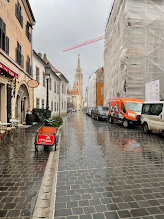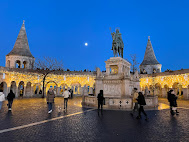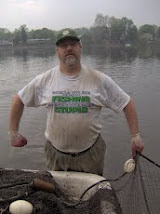DAY TWO
We hired a personal
guide in Budapest Hungary for 2 days while there on a recent trip. Andrea
Makkay is a native of the Hungarian capital and grew up during the Communist era.
She is intelligent and witty, speaks great English and is enthusiastic as a
professional tour guide, and is very flexible as she steers the tour's itinerary to what her client is interested
in seeing of this beautiful, historical, vibrant city. |
Bush statue near the
American Embassy Budapest |
Our first day of
touring with Andrea was a full day minivan tour, driver and umbrellas included.
That day cost €480. It was €140 for the second day, a half-day waling tour
through the Pest portion of the capitol.
METRO
In the days before we
met Andrea we had been to the Opera, to see a performance of Die Fledermaus. We
had strolled Heroes Square and the spacious City Park and spent an afternoon
soaking in the Széchenyi Thermal Baths. So, molding our personalized tour to
other destinations Andrea had us get on the Metro.
Everything we saw on
this second day was within walking distance from our K+K Opera Hotel, but we
took the Metro to save time.
Around the corner from
our hotel was the beautiful Hungarian State Opera House and the Opera Metro
station and at a kiosk Andrea had us purchase 10 pairs of single use Metro
tickets. When we got on the Millennium or Yellow line of the Metro, she showed
us how to validate our tickets in a little machine on the quaint rattling train
and we rode it to last stop at Vorosmarty Square (Ter in Hungarian). We could have taken the
Millennium line (so named because it was constructed in the late 1800s in
celebration of the 1,000-year anniversary of Hungary) the opposite way to the
City Park and the Széchenyi Thermal Baths, but we had decided to walk on a
beautiful warm and sunny early January morning. |
| Cafe Gerbeaud, Budapest |
It was early and the Vorosmarty
Square was empty, but Andrea said it will fill up with shoppers as the day
progressed as it is the beginning of Vaci Street (utca in Hungarian.) This
pedestrian thoroughfare starts at the Great Market Hall and is lined with
restaurants, cafes and tourist shops.
Sadly the popular
Christmas market that is held in Vorosmarty Square was done for the season, but
Andrea gave us the history of the famous Café Gerbeaud, and recommended we stop
later for a coffee and a pastry.
DOWN BY THE RIVER
From Vorosmarty it was
a short walk to the Danube River where Andrea pointed out the Chain Bridge, the
first bridge built to cross the storied waterway and join the cities of Buda
and Pest into one entity. |
| The Chain Bridge, Budapest |
Here there is an above
ground trolley and access to tour boats that cruise the Danube.
The Chain Bridge was
under renovation with cyclone fencing keeping everyone away.
ST STEPHEN'S BASILICA
More than half of all
Hungarians follow the Roman Catholic religion. It’s dominance in this Central
European country was helped along by St. Stephen who “spread the word” by the sword
when he became king in 997.
Beyond Hungary the Russian
orthodox religion is prevalent. |
| St. Stephen's hand |
It was a short walk up
from the river with the chiming bells of St. Stephen’s Basilica filling the air as Andrea filled us in on the history and particulars of the basilica. For instance, it was completed in 1905 and it is 96 meters tall (315 ft), the
same height as the Parliament building, inferring church and state are of equal
importance. The number 96 is important to Budapest because of it commemorates the
settling of Hungary in 896.
There are no skyscrapers
in the center of Budapest as the law requires all buildings to be shorter than
96 meters. Anyway, St. Stephen’s
Basilica was majestic from the outside, but there were church services being
held and no touring allowed. Andrea begged us to go on our own, after our tour
was over. We did the next day, but without her guidance lots of things were
missed, although we did get to see St. Stephen’s right hand encased in a reliquary.
There is a nominal fee to enter the basilica with tickets purchased from a
small office across the street from the basilica.
The square in front of
the basilica is lined with very pleasant cafes and restaurants.
LIBERTY SQUARE |
| Victims Memorial Budapest |
The next stop on our
half-day walking tour with Andrea was Liberty Square. Here we first stopped in
front of the memorial for Victims of the German Occupation and Andrea pointed out
the irony, as many Hungarians were complicit in the holocaust. An anti-memorial
is set up just across the narrow street from the official memorial showing the remnants
of Jewish lives from the atrocities, and is adorned with barbed wire and
protest flyers and artifacts like shoes and suitcases. It was a sobering
reminder of the cruelty.
In the center of Liberty
Square is the one lone Soviet memorial left standing in Budapest. All the rest
have been removed to Memento Park on the outskirts of the city. The reason the obelisk,
topped by a golden Soviet star, had been left in place was because it is a
memorial to the Red Army soldiers who died trying to liberate Hungary from the
Nazis. That control stuff came later. |
Red Army Memorial
Liberty Square |
On one end of the
square is the United States Embassy, and nearby are two statues of U.S. Presidents, Ronald Reagan and George H.W. Bush. Both were instrumental in the collapse of Communism.
Andrea told us how the
crown jewels of Hungary were spirited away to the United States’ Fort Knox for
safekeeping before the war. Later returned by Jimmy Carter in 1978 the crown
jewels are now in the main rotunda of the Parliament building, and are the highlight of a separate tour we would take the next day.
Andrea said they should also erect a statue of Carter
in Liberty Square
Here's some more
history of the crown jewels of Hungary
PARLIAMENT BUILDING
We would take the audio
tour of the interior of the beautiful Parliament Building the next day, but on
our walking tour Andrea had us walk through the spacious Kossuth Square,
dodging trollies and view this magnificent Gothic revival structure built to
rival the Austrian dominance at the time. It was meant to be completed in time
for the 1896 Millennial celebration of Hungary, but finally completed in 1904.
During the Soviet era a massive red star was atop the main dome, but now that’s
in a display of the history of the Parliament Building that is part of the
walking audio tour. |
| Hungarian Crown Jewels |
The front entrance to
the Parliament faces the Danube, but the rear side, facing the square is
dramatic as well. Andrea had us go the visitor center on the far end to get a
closer look (and to use their nice bathrooms).
As we headed towards
the metro on the other side of the Parliament Building and Kossuth Square
Andrea pointed out the Szekler flag of Transylvania that was flying from the
Parliament Building. In reparations for its role in WWI, Hungary signed the
Treaty of Trianon and lost 75% of her pre-WWI territories. Suddenly people who
were once Hungarian were now Romanian, Slovakian, Croatian, Serb, etc. There
are factions within the Hungarian government that feel Transylvania should be Hungarian
again. It was reminiscent of what is happening currently in Ukraine and it’s
conflict with Russia.
 |
| The Parliament Building Budapest |
To read more about the complicated history:TOBACCO ROAD SYNAGOGUE
Ignoring the alluring Szamos
Chocolate Museum near Kossuth Square and quickly eyeing the Memorial honoring
those who perished in the October 25, 1956 revolution against the Communists
(with sobering faux bullet holes splayed along the glass structure), we entered
the Red line Metro stop.  |
| Kossuth Sq escaltor |
It’s very deep and the escalators are very swift, so
hang on! Andrea explained that this part of the metro also doubled as a bomb
shelter and the speedy escalators would spirit people away from danger.
We took the metro to
the Dohany Street Synagogue, the largest in Europe. The synagogue is so named
after the tobacco factory that was once located nearby. Dohany is tobacco in
Hungarian. |
Raul Wallenberg Memorial Park
at Dohany Synagogue |
Dohany Synagogue
charged an admission to tour the interior, like all the churches that we
visited in Budapest, but Andrea instead led us around the exterior, explaining
the architecture and pointing out sobering details from the street.
Over 400,000 Hungarian
Jews died during the Holocaust and many were sent to Auschwitz, but the synagogue
was where many of those who died while in the Ghetto during the Nazi occupation
are buried. Though we didn’t enter the grounds we could see the markers of those
unfortunate souls from the street. She also pointed out the Raoul Wallenberg Holocaust Memorial
park, easily seen through the railings in the rear courtyard of the synagogue
complex. Wallenberg’s efforts during WWII saved thousands of Jews. The memorial
features a metallic weeping willow on whose leaves are inscribed the names of
the victims during this time.
If you’re interested in
reading more about the Dohany Synagogue:
THE GREAT MARKET HALL
We took an above ground
trolley from the Astoria stop to Flovam Square for the next and final destination
of our half day walking tour with Andrea Makkay, The Great Market Hall. Located
near the Liberty Bridge which leads directly across the Danube to Gellert Hill,
where we were the previous day, the trolley dropped us off on a traffic island
in the middle of a busy street.  |
| Great Market Hall Budapest |
The Great Market Hall is perhaps the most
touristed destination in Budapest with three floors of shops offering produce, meats,
dairy products, spices like Paprika, wines, tourist souvenirs and even housewares
like pots and pans. Also found on the upper mezzanine are several eateries and
restaurants. In the basement are the fish mongers and specialty butchers. On
the mezzanine level several eateries and restaurants are
located. This massive airy building was erected in 1897 and the façade is
decorated with famed and colorful Zsolnay tiling which is found throughout Budapest.
Andrea gave us a quick
once-over about the history of this vast indoor emporium and after some pleasantries
we said our good-byes and left us to explore the market ourselves. It was a
wonderful tour; we crammed a lot in over the two days we were with Andrea.  |
| Great Market Hall interior |
So, afterwards we
walked the aisles, found a wine kiosk where we bought several Ikon winery reds for
ourselves and friends, while ignoring the Tokaj sweet dessert wines that were
as plentiful. We then bought chocolate and decorative pouches of paprika for
more gifts, souvenir gifts for the grandchildren and another key chain to add
to our burgeoning collection of such keepsakes from around the world.
If you end up at the
Great Market Hall in Budapest, remember there are lots of stands offering
similar products, like the paprika pouches. If you go you can negotiate on the price. It's easier if you’re buying a lot like we were. The gaily printed pouches with wooden spoons
to dole out the spice do make great gifts, but if you're not satisfied with the price move on to
the next vendor.
THE WOODEN SPOON
We ended our visit to
the Great Market Hall with lunch at the Fakanal restaurant, located on the
mezzanine at one end of the market. Fakanal means wooden spoon in Hungarian. It
was a cafeteria style restaurant that offers traditional Hungarian foods and has
a small gypsy music group playing from noon until 3 pm.
JUST DESSERTS
With our souvenirs in
tow and our bellies filled with hearty Hungarian goulash we strolled down the famed
Vaci Street, but basically ignored all the tourist shops and cafes. Afterall, we
were headed to Cafe Gerbeaud in Vorosmarty Square where we began our walking
tour with Andrea that morning.
First opened in 1858 and
at its present location since 1870 Café Gerbeaud was where Budapest elite took
their coffee. Opulent décor, crystal chandeliers and an array of desserts and coffees
and teas and now offering a breakfast and bistro menu a visit to Café Gerbeaud is
a chance to experience what life was like during the height of the
Austro-Hungarian Empire. |
| Cognac Cherry Dessert |
Our reward for hoofing
it around Pest with Andrea Makkay was to enjoy some decadent desserts at the café.
Though I got the Royal Chocolate Cake slice, Janet won this round by ordering
the Cognac Cherry Dessert that was so beautiful she didn’t want to eat it!
BEYOND THE TOUR
This is a small “slice”
of Budapest, pun intended. We saw a lot, but there is much more to see in
Budapest.
Later that evening we
went on a pub crawl to the Ruin Bars, and the much quieter Tuk Tuk Bar. The
next day we toured the Parliament Building and saw the crown jewels. We finally
visited St. Stephens Basilica and got to see his 1,000-year-old right hand in its
reliquary, but without Andrea to guide us we just took in the beauty of the
basilica. We then had an afternoon coffee at a café on the square before the
basilica. We rode the Budapest Ferris Wheel and after tiring of eating so much rich
goulash over the past number of days we had comfort pizza at the Trattoria Pomo
D’Oro, which was also on the basilica’s square..heic) |
| Parliament interior |
Our first meal in
Budapest was at the Menza Restaurant. Menza is the Hungarian word for canteen,
and this lively place that served traditional Hungarian dishes had retro-60s
era décor. We had to wait briefly for a table, so we hung at the bar and some
drinks. The menu was translated into
English and the portions were massive. We each had a garlic soup topped by a Hungarian
pastry that was filled with sour cream. That was enough, but our entrees, Janet
had Pork and I had a Wiener Schnitzel had our bellies bursting!
Thanks for reading.
Budapest is beautiful, historical and vibrant.
Go!
Love Janet and greg






















.heic)









































